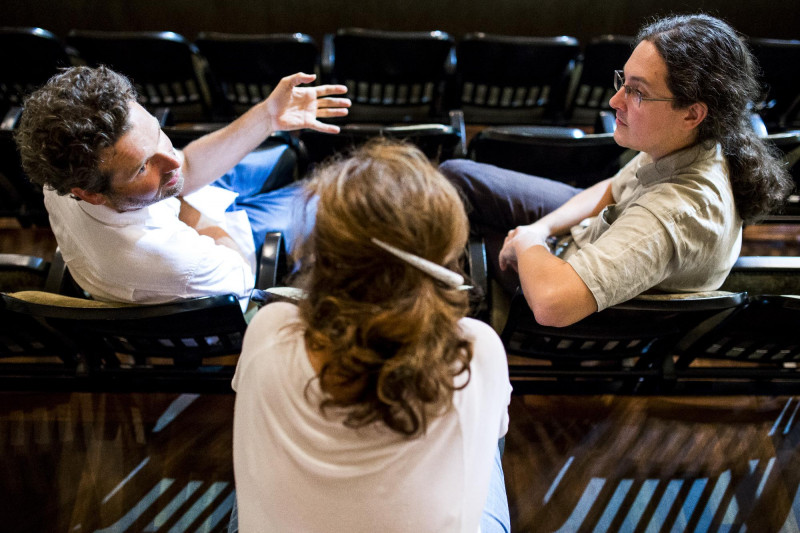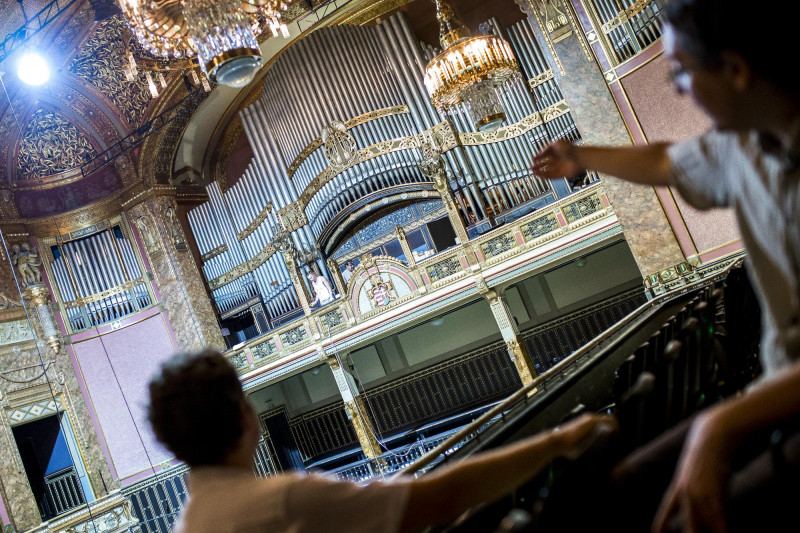PARITY – LÁSZLÓ FASSANG AND BALÁZS SZABÓ
A perfect organ in a perfect hall. Amazing message from the past to the future
’To hear them sounding first time, one-by-one, gave me goosebumps’ –says Balázs Szabó, pointing at the facade pipes of the organ. ’We’ve been watching them for 50 years without hearing them’ – adds László Fassang with a smile. ’First manual, Diapason 16’ – they chorus, talking about the pipes of the organ in the Grand Hall at the Academy of Music, the pipes that have been parts of the scenery above the stage since the beginning, only having been muted since 1967… till now.
In the final stage of the restoration we sit on the gallery of the Grand Hall with László Fassang and Balázs Szabó, looking down at the stage full of lumber and pipes lying around while staff members are trying to communicate with each other between the stalls and the case of the organ in German. All of a sudden the voice of a pipe tuned overwhelms everything else, including our voices, and forces us to go down to the ground floor.
The tuba. This rank used to be heard even in the Solti Hall in those days – says Balázs Szabó already in the calm café. Now teacher at the Keyboard and Harp Department of the Academy has been – as a student – dreaming of having the opportunity to play the restored Voit organ in the Grand Hall. But in the early 2000s a West-German organ, made in 1967 was in place of the original world-class Voit & Söhne instrument and Balázs seemed to be the only one taking care about the old organ, investigating its fate, spooking archives and digging himself into vintage organ cases, since he believed that the Voit organ would come back home one day.

When did you first feel that your dream could come true?
B. Sz. – When I met Laci (organist László Fassang), here, at the Liszt Academy of Music, in 2008. When we were talking for the first time, he asked my oppinion on what instrument could I imagine for the Academy. I felt it was time to get the plan off the ground.
L. F. – We all knew the reconstruction of the building would start soon, and final or terminal deconstruction of the organ in the Grand Hall would be necessary. The question was: which direction to choose for our next steps. Deconstructing then reconstructing a concert organ is not an easy matter at all. I didn’t know too much about the former Voit organ or Voit organs in general and I didn’t have an enhanced plan but Balázs was so cogent that I said okay, lets keep the possibility of rebuilding the original instrument in mind.
We necessarily had to take three aspects into consideration. We wanted an organ that would match the building and would be worthy to enrich concert life and organ collection of the city – so purchasing a modern concert organ like the one in Müpa Budapest wouldn’t have made sense. But we had to take in account the fact that the Academy, as it is a school, needs an instrument applicable for the largest possible scale of teaching purposes and able to inspire students. The original Voit organ, born in the late Romanticism, seemed to meet all three expectations, not at all negligibly for the reason that there are only a few of grandiose romantic organs serving educational purposes. Only two schools have organs comparable to this one in size and quality, the Tchaikovsky Moscow State Conservatory and the Yale University in the USA.
This organ was originally designed for and built up in this building, in this very Grand Hall. But it has been dismantled, carried away and scattered about. How many locations its pickings were to be found?
B. Sz. – We knew that most parts had gotten to Győr and Fertőd, so we first visited those places. We found a lot of pipes and important and valuable parts there. But several pipes and – practically speaking – complete ranks were found in five other locations. These parts became rebought by the Academy during those years. Actually, we got back everything known to be existing. The research, however, was not easy as the original documentation and blueprints from 1907 had disappeared and no copies could have been found. Neither in the archives of the Academy nor in the National Archives. We had to find another way to find out what to look for. On the occasion of the 1925 restructuring, Angster Organ Manufacture made blueprints of the organ’s inner structure and measurements of its state. Checking the blueprints against the original parts, we saw the drafts of the inside thay had made, were completely accurate. So based on these we could reconstruct the positions of all the blowers and windchests, the supporting structure, the order of ranks… important pieces of information that had not survive in any other form but play an important role in the authenticity of sound.

Was this investigation or research accomplished by Balázs?
B. Sz. – Yes, my life has been dedicated to the Voit organ since 2005. I began my research in the archives of the Academy going on in several Hungarian and German archives of places where Voit organs could be found. Even in the files of the Walcker company – producer of the organ that took the place of the original Voit here – I could find photos taken before the deconstruction. Photographs and heritage of organ coursebook author Dezső Antalffy-Zsiross also helped a lot. The idea that motivated me, was not a nostalgic attitude towards reclaiming a piece of the past, but the belief or rather persuasion that this instrument was an incomparable masterpiece with its unique quality of sound all around the globe.
Laci, what did you think about this young colleague so enthusiastic towards his dream?
L. F. – I just remembered, listening to him talking now, how impressed I had been by his enthusiasm, though he then was just a graduate fresh out of school. But this level of faith and enthusiasm brought us together as a common feature. I still keep marvelling the amount of energy he begins a new task with. Request or guarantee we had none from anybody, so being entrusted with this project seemed to be a dream for us. But one thing was clear: nothing will happen if we don’t do everything we can. Gergely Lakatos, chief engineer of the Liszt Academy of Music supported the restoration by all means and made important steps during the renovation of the building itself, which aimed the implementation of the organ restoration project possible. Organist teacher colleagues István Ruppert and János Pálúr helped by all possible means as well and we decided to get this to a point of no return.

All that without money?
L. F. – At that point in time: yes. We lived an adventurous life in that guerilla-period. Getting back the original organ parts with an actual lack of resources before the official project gets the go-ahead was exciting and it challenged all our creativity. Gergely Lakatos connecting the issue with the greater project of restauration after a decision of the Academy Senate made things easier, giving us larger freedom to act.
B. Sz. – Production of the preparatory phase documentation itself took thousands of working hours. Meanwhile the moment of renovation reaching the organ facade has become closer and closer every day. Which facade was originally 60 cm behind the Walcker’s. The ’organ seats’ here, made for the students can be seen on old photos. The decision to go on with the construction meant that the Voit had to return as the Walcker could not have been placed to the new, tighter place.
L. F. – The Walcker organ was built behind the plain of the facade of the Voit in the 60s. These pipes were mute, the whole thing was a horror with friezes cut and pipes propped up with dexion accessories and iron bars. But in case we restored the original facade, a new organ would be needed. And then we got to the decisive moment. The zero hour. We already had everything – documentation, plans, blueprints, quotations – loaded, we just had to put it onto the table and say: here you are, the Voit.

It’s done. It has sounded. What is it like?
B. Sz.– It went above and beyond all my expectations. We touched and pawed every single pipes, blew them with our mouths saying ’wow, listen to this one, no, that one, hey, what a fantastic sound this one has etc.’ without hearing their real sound in the Hall. When it was able to work – the wind blew, the magnets worked and the system stood up, we began to sound the pipes of the facade one by one. It was a moment beyond expression. Even thinking of it gives me goosebumps. A sound we did not – we could not – expect was heard. Extremely clear in each register. Not good-here-but-slurring-and-cracked-there-and-there, no, excellent sound in all ranges. A perfect organ in a perfect hall. An unbelievebly clear message from the past to the future.
L. F. – I am sure that it will overwrite our image of the organ as an instrument. Both the professionals’ and the audience’s. And as of the students, it opens up a brand new world for them. The Academy hasn’t had an organ since I have started teaching here. We have been teaching in the Bach Hall at the Old Academy Building and in several churches around Budapest. It feels uplifting to think it over: what a high level they will start off, the ones who will not struggle and make compromises like us, but will be inspired by such an organ in such a perfect building with such a past.
Ágnes Mester


